
Newcastle upon Tyne, or simply Newcastle, is a cathedral city and metropolitan borough in Tyne and Wear, England. It is England's northernmost metropolitan borough, located on the River Tyne's northern bank opposite Gateshead to the south. It is the most populous settlement in the Tyneside conurbation and North East England.

Tyne and Wear is a ceremonial county in North East England. It borders Northumberland to the north and County Durham to the south, and the largest settlement is the city of Newcastle upon Tyne.

The River Tyne is a river in North East England. Its length is 73 miles (118 km). It is formed by the North Tyne and the South Tyne, which converge at Warden near Hexham in Northumberland at a place dubbed 'The Meeting of the Waters'.
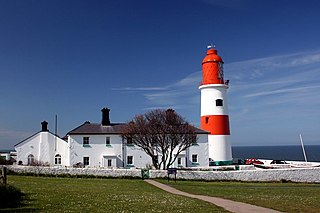
South Tyneside is a metropolitan borough in the metropolitan county of Tyne and Wear, England. It is bordered by all four other boroughs in Tyne and Wear: Gateshead to the west, Sunderland in the south, North Tyneside to the north and Newcastle upon Tyne to the north-west. The border county of Northumberland lies further north. The borough was formed on 1 April 1974 by the merger of the County Borough of South Shields with the municipal borough of Jarrow and the urban districts of Boldon and Hebburn from County Durham.
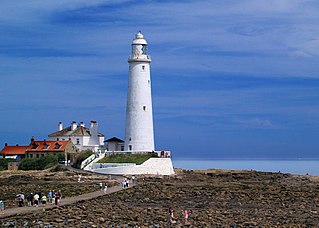
North Tyneside is a metropolitan borough in the metropolitan county of Tyne and Wear, England. It forms part of the greater Tyneside conurbation. North Tyneside Council is headquartered at Cobalt Park, Wallsend.

South Shields is a coastal town in South Tyneside, Tyne and Wear, England; it is on the south bank of the mouth of the River Tyne. The town was once known in Roman times as Arbeia and as Caer Urfa by the Early Middle Ages. In 2021 it had a population of 75,337. It is the fourth largest settlement in Tyne and Wear, after Newcastle upon Tyne, Sunderland and Gateshead.

The history of Newcastle upon Tyne dates back almost 2,000 years, during which it has been controlled by the Romans, the Angles and the Norsemen amongst others. Newcastle upon Tyne was originally known by its Roman name Pons Aelius. The name "Newcastle" has been used since the Norman Conquest of England. Due to its prime location on the River Tyne, the town developed greatly during the Middle Ages and it was to play a major role in the Industrial Revolution, being granted city status in 1882. Today, the city is a major retail, commercial and cultural centre.

The Quayside is an area along the banks (quay) of the River Tyne in Newcastle upon Tyne and Gateshead in Tyne and Wear, North East England, United Kingdom.

Hebburn is a town in the South Tyneside borough of Tyne and Wear, England. It was formerly in County Durham until 1974 with its own urban district from 1894 until 1974. It is on the south bank of the River Tyne between Gateshead and Jarrow and opposite Wallsend and Walker.
Evolution Festival was a music festival held annually across Newcastle upon Tyne and Gateshead, England, from 2002 until 2013. The festival attracted tens of thousands of attendees every year and usually took place on the Quayside. Evolution Festival was briefly titled Orange Evolution due to a sponsorship deal with the mobile phone company Orange. It has been described as "the biggest festival Tyneside has ever staged".
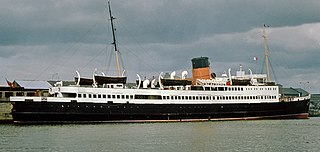
TSS Manxman was a passenger ferry launched from the Cammell Laird shipyard, Birkenhead, on 8 February 1955. She was the final vessel in a class of six similar ships, the Six Sisters, ordered by the Isle of Man Steam Packet Company, and was the second of the Company's ships to carry this name. She was withdrawn from service in 1982. Following a failed preservation attempt, and featuring in a music video in the process, the ship was broken up at Sunderland in 2012.
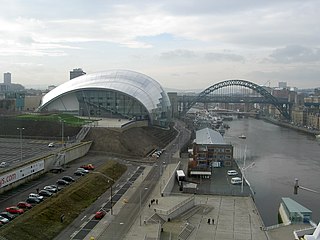
HMS Calliope is a training centre and 'stone frigate' of the Royal Naval Reserve, located in Gateshead, Tyne and Wear.

QuayLink was a bus service in Tyne and Wear, England, which connected Gateshead and Newcastle upon Tyne, and later North Tyneside, with the Quayside. Funded by the Tyne and Wear Passenger Transport Executive, the service was launched on 22 July 2005. Operated initially by Stagecoach North East, the service was transferred to Go North East in July 2010 – later being operated commercially from July 2015, following budget cuts.

Tyne and Wear is a metropolitan area covering the cities of Newcastle upon Tyne and Sunderland, as well as North and South Tyneside, Gateshead and Washington.

The Gateshead Garden Festival was the fourth of the United Kingdom's five national garden festivals. Held between May and October 1990, in Gateshead, Tyne and Wear, it lasted 157 days, and received over three million visitors. Attractions included public art displays, a Ferris wheel, and dance, music, theatre and sporting events. The site comprised four areas: Norwood, Riverside, Dunston and Eslington Park, and several modes of transport were provided around the site: a monorail which ran between Norwood and Eslington, a narrow gauge steam railway between Dunston and Redheugh, and a road train which covered the entire site. A ferry across the River Tyne, between Dunston Staiths and Newcastle Quayside, was also provided.
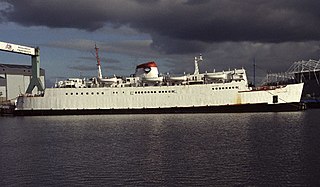
TSS Dover,, was a British ferry. Built in 1965 as a roll-on/roll-off (RORO) ferry, she spent much of her later life as one of the permanently moored Tuxedo floating nightclubs before being laid up, latterly on the River Tees in Middlesbrough.

TSS Caledonian Princess was a turbine steamship, built by William Denny & Brothers in 1961. A roll-on/roll-off car ferry, she primarily served the Stranraer - Larne route. Under Sealink ownership, however, she operated in both the English Channel and the Irish Sea. From 1984, she spent her later life as the Tuxedo Princess, a floating nightclub on the River Tyne. She never saw service under her final name, Prince, and was scrapped in 2008.

The North East Combined Authority (NECA), officially the Durham, Gateshead, South Tyneside and Sunderland Combined Authority, was one of the combined authorities in North East England. It was created in 2014, and consisted of the City of Sunderland; Metropolitan Borough of Gateshead, South Tyneside; and Durham County local authorities.
Offshore Group Newcastle or OGN Group are a British company that fabricate steel in North East England, often for oil platforms. It is Tyneside's largest manufacturing yard.

The North of Tyne Combined Authority was a mayoral combined authority which consisted of the local authorities of Newcastle upon Tyne, North Tyneside, and Northumberland, all in North East England. The authority came into being on 2 November 2018 under the statutory name Newcastle upon Tyne, North Tyneside and Northumberland Combined Authority. The three local authorities previously formed part of the North East Combined Authority, which continued to exist covering a smaller area. The two combined authorities cooperated on the North East Joint Transport Committee.



















